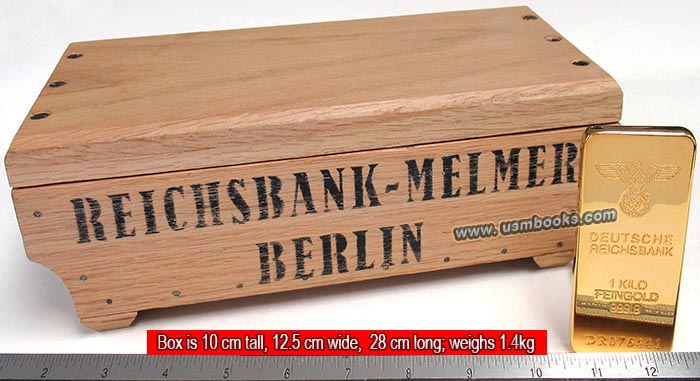
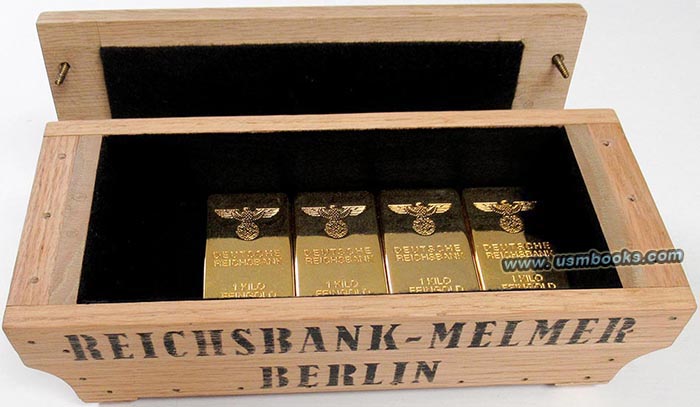
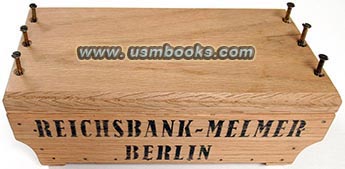
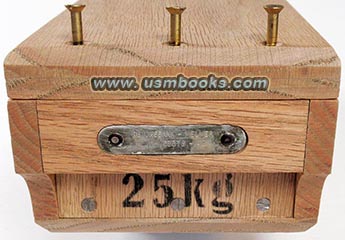
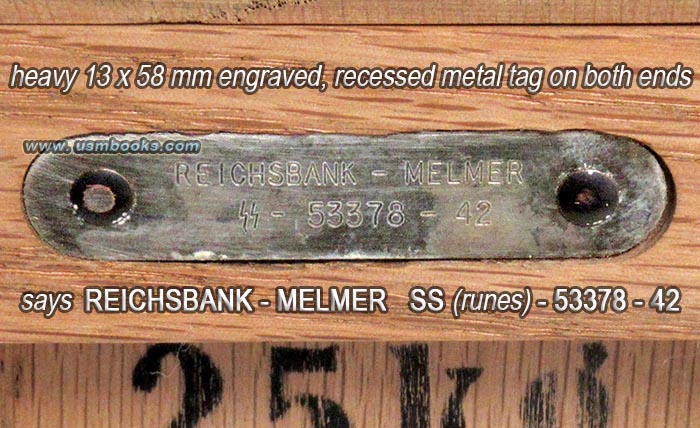
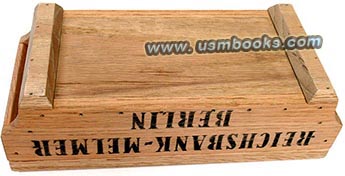

Our case is a perfect wooden reconstruction, made for instructional purposes, for a movie, for TV, or some such use. It is made of thick solid oak, sturdily constructed and marked on two sides with the large black letters REICHSBANK - MELMER BERLIN, and on the ends 25 kg. Both ends also have a heavy 13 x 58 mm engraved metal tag recessed into the oak, on which it says REICHSBANK - MELMER SS [runes] - 53378 - 42. Below the handles, on the ends each of them is stamped with the date 12 Juli 1942.
* A VERY BRIEF HISTORICAL OVERVIEW |
| Because of its relative rarity, its beauty, its compactness, its resistance to corrosion and its adaptability as a manufacturing material, gold has long been sought after and saved. From the earliest of times, humans have collected it, worked it as an artistic material, used it as a medium of exchange, to support less valuable currency, and to settle debts. In Germany in the early 1930s, Adolf Hitler was campaigning for the election of Nazi candidates to the Reichstag (parliament) and for himself. By January 1933 the Nazis had been elected in great numbers and Hitler had become Chancellor of Germany by a normal, democratic process. Once in control and with no further need for the democratic process, Hitler eliminated opposition parties advancing his Nazi Party to absolute control. Hjalmar Schacht was quickly appointed by Hitler as president of the Deutsche Reichsbank (German National Bank) and immediately began a hidden gold reserve program like that used by the Kaiser in preparation for World War I. In just a few years of “die Strenge” (austerity) in Germany the Deutsche Reichsbank was able to hide over 500 million Reichsmarks (one Reichsmark = US$ 0.40 in 1940) in monetary gold in secret accounts under Schacht. World bankers were left to assume that Reichsbank gold was equal only to published figures, or around 70 million Reichsmarks. With the invasion of Belgium, the Netherlands, Denmark, France and Luxembourg in May of 1940 the Germans were able to exchange Reichsmarks for $4,858,000 of Luxembourger gold held at the Bank of France in Marseilles, and through a complicated system which charged the Netherlands for the German occupation, extracted $163,000,000 worth of Dutch gold. The Belgian National Bank, in anticipation of a possible German invasion, had placed their gold reserves in the hands of the French government for safekeeping. The Bank of France shipped it to French West Africa prior to the French surrender to the Germans after only six weeks of resistance on 25 June 1940. When French authorities agreed to the German military occupation of northern France (including the capital city of Paris) they decided to move the legitimately elected government of the country from Paris to the old resort city of Vichy in unoccupied southern France. There the French Government entered into negotiations with the Reichsbank that eventually led to the surrender of the 4,944 sealed boxes of Belgian gold bars with a value of $223,200,000. While the French were sacrificing the Belgian treasury, the great bulk of the $2,000,000,000 of French gold reserves sat safely in the United States, England, Canada and at Fort-de-France on Martinique, well out of reach of the Nazis. Even before the French handed over the Belgian gold, the Deutsche Reichsbank had been in negotiations with the remaining directors of the Belgian National Bank to purchase it. In the end, the Belgians rejected the German offer, so along with a good deal of Dutch gold, the Belgian gold was secretly taken to the Prussian State Mint in Berlin for resmelting. It quietly became Nazi gold. While it is true that “gold has no smell”, and thus can be hard to trace, bars of monetary gold are always well-marked with smelt numbers, serial numbers, names and purity, and are registered in the books of the banks that own or hold them. To resmelt gold bars which have provenance is unthinkable specifically because it causes known gold to “disappear” and “creates” new gold. In the hope of avoiding detection at a later date, the Belgian and Dutch gold that the Germans resmelted at the Prussian State Mint in 1942 and 1943 was given German smelt numbers and stamped with dates arbitrarily selected from years before 1939. Like all the other gold the Nazis possessed, the resmelted Dutch and Belgian gold became the food on which the German war economy fed. When the Germans wished to purchase an element critical to their war effort, ten Swedish machine tools for example, they could open a Reichsbank letter-of-credit in the amount of $10,000 to a manufacturer of those tools in Sweden. The letter-of-credit was essentially a post-dated check payable in gold or in the currency of choice of the manufacturer - anything from Swedish kroner to American dollars - after the manufacturer shipped the ordered machine tools to the Germans. By the middle of 1942 the Nazis had looted, purchased or appropriated virtually every last ounce of monetary gold in Europe. Other sources of gold needed to be found, and an immediate but small reserve came to the Reichsbank in the form of non-monetary gold and other valuables deposited with it by Heinrich Himmler’s “government within a government,” the Schutzstaffeln, or the SS. The Reichsbank had for a long time illegally falsified its records to hide the origins of its monetary gold and had engaged in other unethical banking practices. Their success was due in large part to the collaboration of the Swiss, French, Swedes, Portuguese, Spanish and Rumanians who blissfully looked the other way and took the gold regardless of its origins. While those practices were illegal or unethical, the Reichsbank was always able to justify the transactions in their bookkeeping since the gold obtained was either purchased with Reichsmarks or offset with other bank charges, like occupation costs. Such was not the case with the SS loot. It was not purchased and could not be offset by bank charges in the bookkeeping. It was booty. SS valuables deposited with the Reichsbank consisted of gold, silver, currency, jewelry, dental gold, gold eye glass frames and other items. Arrangements for the deposit of SS valuables were made verbally at the highest level (between Reichsführer-SS Heinrich Himmler and Walther Funk) with all details handled by the SS-Wirtschafts- und Verwaltungshauptamt (SS-Economic Activity and Central Administrative Authority) which also administered SS enterprises and concentration camps. Although the SS loot arrived at the Reichsbank in sealed boxes, the boxes had to be opened to conduct a receiving inventory. All deliveries of SS loot were entered in the Reichsbank books under the code name “Melmer”. Between August 1942 and March 1945 the SS made 76 deliveries to the Melmer account in the Reichsbank, having an aggregate value of $14,500,000, the great bulk of it in foreign bank notes and gold. On Saturday 07 April 1945 soldiers of the US 19th Division of General Patton’s Third Army entered the Kaiseroda Potassium Mine in the small village of Merkers, near Bad Salzungen in western Thuringia, Germany. They found fine art paintings and bags of Reichsmarks, and a huge chamber filled with large quantities of gold bar and coin, bales of currency; suitcases of silverware, jewelry, church ornaments and tableware. While precedent in international law provided that, “any movable property of an enemy becomes the property of the capturing power”, the Americans realized they were only temporary custodians of the greatest treasure ever found. A quick estimate placed the value of the gold alone at more than $241,000,000 based on the established price of US$35.00 per fine ounce. The value today would be something on the order of 124 billion dollars! The non-monetary SS loot and the monetary gold discovered at the Kaiseroda Mine in Merkers was removed by a convoy of military vehicles to the US Army Foreign Exchange Depository (FED) in Frankfurt am Main. The Merkers discovery represented 91% of all the monetary gold found in Germany at the end of the war, about half of it in gold bars. Ninety-two of the thousands of gold bars carried on the Reichsbank books are yet to be found. Approximately 74% of the $770,000,000 in Reichsbank gold that Hitler had at his disposal during World War II was “looted” gold. At war’s end the Allies had recovered about $330,000,000, so the remaining $440,000,000 had to be sitting in the bank vaults of the neutral profiteers - Switzerland, Sweden, Turkey, France, Spain and Portugal. The great bulk of it, some $378,000,000 can be traced on Reichsbank books as it passed into the hands of the Swiss National Bank, principal player in the greatest money laundering scheme in history. |
We have only ever seen one case such as this and we bought it immediately, many years ago. This is it. We are certain there are no others. This is a unique opportunity to purchase the ultimate curio, a full-size replica of a case for 25 Nazi Reichsbank goldbars.
This is a very beautifully made solid oak case properly constructed and marked for the storage and shipment of Nazi Reichsbank 1 kilogram (2.2 pounds) gold bullion bars as held in the Reichsbank for Heinrich Himmler’s MELMER account in Berlin. For those who’d like a comprehensive historical overview of Nazi Reichsbank gold, we include one below following the description of the oak case we are selling here. *
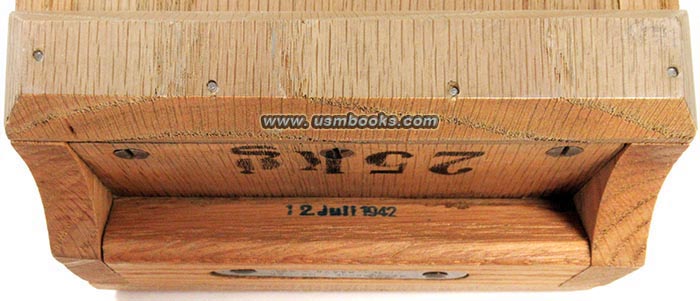
Our pictures depict the heavy solid oak box we offer for sale on this USMBOOKS web page with a replica of one of the DEUTSCHE REICHSBANK 1 KILO FEINGOLD bars in front of it. We are offering only the empty box measuring about 4 x 5 x 11 inches and weighing just over 3 pounds. We have no replica goldbars, only the beautifully made case for 25 of them. Replica goldbars can be found for sale by dealers on the internet.
With the collapse of the banking system in Nazi Germany in early 1945 the Melmer gold holdings in Berlin were moved to the Kaiserode potassium mine in the town of Merkers, near Bad Salzungen in western Thuringia, Germany in boxes on the scale of this one.
In the movies and on TV, the Nazis are always shown carrying away huge boxes of gold the size of a footlocker which of course, is preposterous. Most of the gold bullion in the hands of the Nazis was made to a European international standard of small bars measuring about 4 inches tall x 1-3/4 inches wide x 1/2 inch thick (100 x 45 x 12 mm) and weighing 1 kilogram each, or about 2.2 pounds. Twenty-five such bars in this wooden case would still be portable but heavy, weighing about 26-½ kilograms or nearly 60 pounds.
In the movies and on TV, the Nazis are always shown carrying away huge boxes of gold the size of a footlocker which of course, is preposterous. Most of the gold bullion in the hands of the Nazis was made to a European international standard of small bars measuring about 4 inches tall x 1-3/4 inches wide x 1/2 inch thick (100 x 45 x 12 mm) and weighing 1 kilogram each, or about 2.2 pounds. Twenty-five such bars in this wooden case would still be portable but heavy, weighing about 26-½ kilograms or nearly 60 pounds.
The only one left in the world!
Have a look at other offerings on USMBOOKS.com. We are happy to combine shipping of multiple purchases!
for sale for $275.00 delivered by Parcel Post in the continental USA. |
| • IF you prefer faster and safer Priority Mail shipping with USPS Tracking add $13.50. |
| • IF you wish to purchase highly recommended, but optional insurance, add $4.50. |
| • We will be happy to ship abroad at additional cost, however foreign customers are responsible for any VAT payments, import duties & customs clearing fees. Please inquire. |
REPLICA WOODEN CASE FOR 25 ONE KILOGRAM
BARS OF NAZI REICHSBANK GOLD
THE ULTIMATE THIRD REICH COLLECTOR CURIO!

